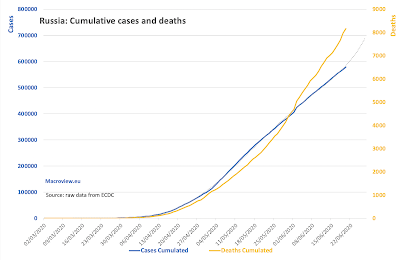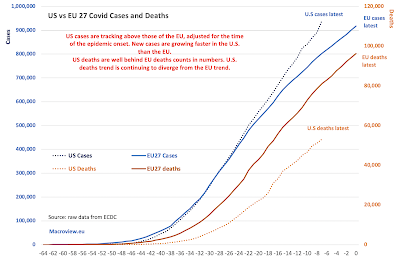"Poekhali!" sad Vlad, refraining Yuri Gagarin's famous phrase. And just like, with a sweep of his hand, Mr. Putin has
- Removed the entire Russian Cabinet, including his long-serving pal, now ex-Prime Minister Medvedev;
- Outlined a hefty set of forward-promised reforms; and
- Added billions of dollars to the Global GDP by creating a tsunami of Russia-related analysis, opinion pieces, reports and updates in the vast Kremlinology Sector bridging journalism, opinnionism, and think-tankerism.
WTF happened in Moscow today?
Putin has been under some sustained pressure in the last couple of years on the domestic economy front. Russian economic growth has been anaemic, to put it mildly. Let's take a brief walk through some headline figures (to-date):
- Despite the 'recovery' from 2015 recession (GDP down 2.3%) and 2016 stagnation (GDP up 0.3%), Russian economic growth peaked at 2.3% in 2018 and slumped to 1.1% in 2019 (based on January-September stats).
- Industrial production is up 2.4% y/y in 2019 (latest data is for January-November) which is worse than 2.9% in 2018, but still miraculous, given the state of Russian Manufacturing PMIs (see: https://trueeconomics.blogspot.com/2020/01/5120-bric-manufacturing-pmis-4q-2019.html).
- Fixed capital investment is in a dire state: in Q1-Q3 2019, investment is up only 0.7%, down from the rate of growth of 4.6% in 2017 and 4.3% in 2018.
- Retail sales are up 1.6% in 2019 (January-November data), but behind 2.8% growth in 2018. Retail sales rose 1.3% in 2017. None of this enough to recover the sector from a wave of massive contractions in 2015-2016, when retail sales fell 10% and 4.8%, respectively.
- Exports have recovered, but are still running below 2011-2014 period averages.
- Current account surplus is still positive, but way lower than in 2018.
- Unemployment is a bright side, at 4.6% in H1 2019, down from 4.8% in 2018, currently - the lowest on record.
- After years of growth, population is set to slightly contract in 2019 compared to the post-Soviet peak of 2018. The change is estimated and is not statistically significant, but it indicates one breakaway from the prior trend: inward migration into Russia has slowed down substantially in 2018-2019, in part due to anaemic economy.
- Fiscally, Russia is doing brutally well, however. Government surplus of 2018 - at 2.6% of GDP is likely to be exceeded in 2019: January-November data puts surplus at 3.1% of GDP.
- Central Government Debt is at 13.7% of GDP as of October 2019, a slight uptick on 11.5% in 2018 and hitting the highest level since 2005, but more than benign, given it is entirely offset by the sovereign wealth funds and is being effectively shifted out of foreign currencies and into Rubles. As a reminder, in his first year in the Presidential office, Putin faced Government Debt of 79% of GDP, with External Debt being 67% of GDP. In 2019, external debt is at around 3.9% of GDP.
- Oil reserve funds are up massively in 2019. In 2018, the funds amounted to USD 58.1 billion. At the end of September 2019, this stood at USD 124 billion. Including FOREX and Gold reserves, and other sovereign wealth funds, Russian Government had USD 530.9 billion worth of reserves as of September 2019, almost back to the peak of USD537 billion in 2012.
- Inflation has ticked up in 2019. inflation hit an all time low of 2.9% in 2018 and over January-November 2019 this rose to 4.6%. Inflation has been a major historical point of pain in Russia, so return to above 3% price increases environment is a troubling matter, especially as the economy is barely ticking up any growth.
- Average monthly wages in rubles are growing: up from RB 43,431.3 in 2018 to RB 46,549.0 in 2019 (October data). And wages are up in Euro terms (from EUR587.1 in 2018 to EUR654.1 in 2019). Average wages are also rising in USDollar terms. Which is a point of improvement for the Russians.
All of which brings us back to where Mr. Putin was standing at the end of 2019: he was presiding over an anaemic economy with some marginal signs of improvement and a growing dissatisfaction amongst his electorate with the Government management of the socio-economic conditions. Here is a snapshot of Vladimir Putin's and Dmitry Medvedev's approval ratings as collected by the independent Levada Center:
http://www.levada.ru/en/

Notice much? Yep. Traditionally, Russian voters have placed increasing blame for deteriorating socio-economic conditions on the Government, as opposed to the President. Recent years are no exception. The last points on these charts is November-December 2019. Putin's approval ratings have basically stagnated from 3Q 2018 on, while Mr. Medvedev's ratings continued to slip.
Here is a nice kicker: majority of Russians are increasingly not seeing an alignment between their interests and the objectives of the Government. Again via Levada:
"Probably not" and "Definitely not": 2007 = 62%, 2009 = 65%, 2011 = 68%, 2013 = 67% and ... 2019 = 72%. Other signs of pressure? Position: "The government lives off the people and isn’t concerned about how normal people live" - support = 53% in October 2019 poll.
So Putin has been facing some major dilemmas in recent months. Chief ones are:
- How to shift economy toward a faster growth path?
- How to resolve the 2024 exit strategy without triggering an internal 'civil servants war' in the corridors of power? and
- How to secure an upside to his legacy (remember, recency bias means that people remember more recent actions / legacies of their leaders, as opposed to the more distant ones)?
Step one in dealing with the three dilemmas is: replace the unpopular Cabinet. Step 2 is: announce new reforms that - by historical experience - must include things that haven't failed before (e.g. focus on longer term political reforms as opposed to the shorter term market reforms). Step 3 is: quietly unleash a host of economic development policy changes (these are not reforms per se, but a rather policy tools that cannot be deployed by the current, status quo-anchored, Cabinet).
Unless you are a tin-hat-wearing member of the Putin World-Domination Conspiracy club, so far - rational, right?
So Putin announced that he will
- gradually (a good thing, given weak institutional capital in Russia)
- rebalance the executive power away from the Presidential status quo
- toward a more co-shared power arrangement with the Duma (Russian Lower House of the Parliament).
- The only three details Putin mentioned today on the subject are:
- Letting Duma elect the Prime Minister;
- Giving Duma the power of appointing the entire Cabinet of Ministers and all Deputy Prime Ministers; and
- The President will have no veto power over the Duma on these appointments.
The whole idea is not new.
Yeltsin dramatically reduced Parliamentary powers after the 1993 'Constitutional Crisis' - an event that saw the West applauding him for bombing the Parliament. Putin subsequently tightened the Presidential grip on power, motivated, at least at first, by the reality of the post-Yeltsin Russia spiralling into a series of smaller secessionist civil wars. Yeltsin made a deal with the devil in his last election: in exchange for the regions support for his hugely unpopular Presidency run, he gave regions more autonomy. On his timescale, Russian Federation would have been a wedge of Swiss cheese, riddled with newly independent ethnic and religious enclaves, by the mid-2000s. Under Putin, Moscow had consolidated its power, suppressing ethnic strife and nationalist extremism. By 2009, then-President Dmitry Medvedev started talking about the need for development of a functional opposition to the Kremlin-backing party, the United Russia. Chats about devolution of power back to the Parliament were mooted. In the end, Medvedev's reforms program included none of the political reforms to challenge the Kremlin. Worse, Medvedev's Police reform of 2011 was an exercise in federalization of the police force, effectively removing much of the local control over the cops. That said, the same reform significantly curtailed the imbalance between the rights and the duties of the police, giving more rights to the citizens.
Now, the idea of devolution of power is back. Why? Because today's Russia faces three important realities:
- Reality of a stagnant economy - traceable back to 2011 and post-2014 collapse of oil prices. This stagnation outlived the economic promises of the Medvedev's reforms and the endless statements from Putin about the need for diversification of the Russian economy;
- Reality of shifting voter preferences away from supporting geopolitical re-entry of Russia into the exclusive club of countries that 'matter' toward domestic agenda; and
- Reality of the Putin presidency facing the end game of transition of power - something that virtually never has been achieved in the past without a major mess.
One way or the other, the idea of giving Duma a meaningful say in the formation of the Government is a good idea for Russia. And one way or the other, it will provide new incentives for a gradual (over the longer period of time) evolution of the Russian body of politics away from the rubber-stamping 'opposition' to the ruling United Russia (the status quo) and toward genuine competition in policies and ideas. This, too, is a good thing for Russia. In fact, I can't really find anything bad in the Putin's latest idea, without forcing myself to think in conspiracy theory terms.
Therefore, to me, the main question that everyone should be asking is not whether or not Putin is proposing these reforms in order to remain in power post-2024, but whether such reforms are feasible today. My gut feeling is that they might be. If the Duma is given real powers, starting with the powers of selecting the Government Cabinet, skin-in-the-game incentives for political parties participation in legislative process beyond today's political posturing will rise. This can, over time, lead to the emergence of a genuine and more effective opposition - the one, driven by policy debates and competing world views. Will it happen? I don't know. Does Putin know? I doubt.
Frighteningly, not a single journalist I've read on the topic today asked these questions of feasibility of the reforms. Instead, all focused on scaremongering their readers into believing that the announcement is yet another dastardly Putinesque plot to [insert the humanity destroying disaster of your choice here].
CNN produced this utter garbage for analysis:
The CNBC folks decided piped in with this one"
Neither august outfit of 'world class journalism' has managed to notice the fallacy of their 'damned if he does anything, and damned if he does nothing at all' logic. But enough morons. The real test of Putin's 'reforms' will come post 2024. Until then, watch the proposals for the referendum take shape.
PS: Will we miss Medvedev? Well, he sure beats the tax collector who will replace him. At least in charisma, diplomacy and economic thinking. But not in accountancy.










































